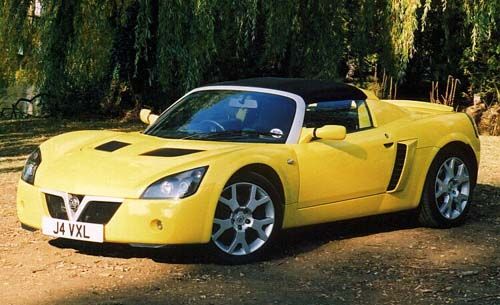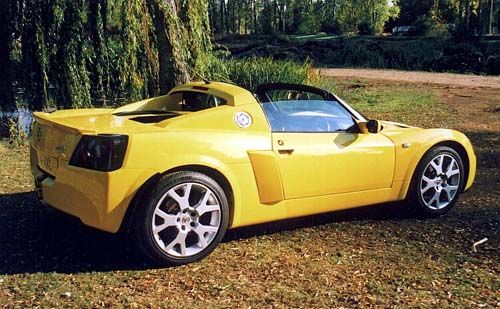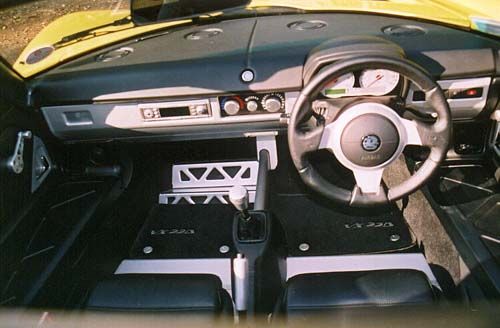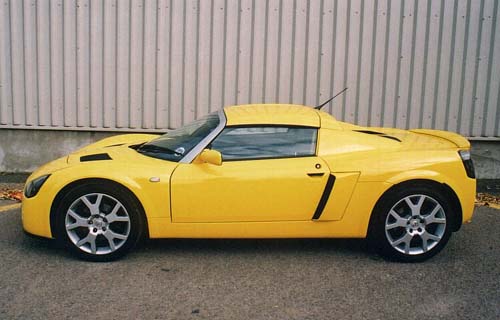VX220 Turbo
Graham Bell tests a Vauxhall but looks beyond the badge
Chances are that from its advertising this year, most of you know that this is Vauxhall’s centenary. What most of you probably don’t know though is that back in its early years, Vauxhall was regarded as something of an upmarket sporting marque. In fact prior to World War One Vauxhalls set several class speed records, held the lap record at Brooklands and posted a time at Shelsley Walsh hill-climb so far ahead of the competition that it remained the course record for 15 years.

The reason I mention this is that these days Vauxhall is generally regarded as anything but a sporting marque. In fact when the VX 220 was originally launched some people immediately dismissed it purely because of the badge, stating that Vauxhall 'had no sporting heritage'. In reality Vauxhall have a sporting heritage that spans 100 years and continues to this day. After all, who’s been BTCC champion for the last three years?
But despite all their Touring Car successes, up until the launch of the VX 220 you’d struggle to find anything in Vauxhall’s recent line up that could be described as a high performance car to excite the enthusiastic driver.
The VX220 is of course essentially a modified Elise with a Vauxhall engine, different body panels and a few sops to the mainstream buyer. However, as Vauxhall discovered from the poor sales figures, most people who buy this sort of car would rather have a Lotus badge than an airbag and ABS. But with the VX220 Turbo offering over 40bhp more than the Elise 111S for £500 less, it’s had a lot of people thinking that maybe a Lotus badge isn’t that important after all.
Power
That tempting turbo isn’t attached to the ‘original’ VX’s 2.2 litre all alloy-engine but comes courtesy of a parts bin labelled ‘Astra GSi engines’. These 2-litre units use iron rather than alloy blocks, which along with all the turbo gubbins means the VX Turbo weighs 55kg more than the standard model at 930kg.
Compared to Evos and WRXs, the VX Turbo’s maximum output of 200bhp at 5,500rpm looks a bit tame, indicating a mild set-up. This is backed up by the torque curve which is – literally – flat from 1950rpm to 5500rpm, between which it produces a useful 184 lb ft.

Transmitting this to the back wheels is the same Getrag 5-speed gearbox used on the normally aspirated VX, though to make better use of the increased power and torque both final drive and fifth gear ratios have been raised, producing a long-legged 25mph per 1000rpm in top.
Despite its extra power and weight, the Turbo also uses the same 288mm vented discs all round as the standard version (with alloy callipers from AP Racing front and Brembo rear) but does offer the option of drilled discs as fitted to the test car. The all round unequal length double wishbone suspension has been beefed up though, with spring and damper rates increased by 7% at the front and 11% at the rear.
Body
Looks wise, external differences between the turbo and the standard VX run to a couple of discreet black ‘splitters’ on the front, a body coloured spoiler on the back, some purposeful looking air scoops on the flanks and new wheels with forked spokes. The scoops and spoiler definitely help add to the ‘junior supercar’ image, and the VX turbo certainly has a real presence on the road (especially when painted in eye-catching Brilliant Yellow!) eliciting vociferous approval on more than one occasion from gangs of lads. Seems there’s hope for the Max Power generation yet…
It cuts the sports car mustard on the inside too. Ensconce yourself in the VX’s driving seat, and even though there’s a Vauxhall badge in front of you there’s no doubting you’re behind the wheel of something special. For starters, there’s that low slung, sit on the floor race-car driving position, the small steering wheel and all that exposed aluminium. Then there’s that interesting forward view between the distinctive angular curve of the front wings.

Apart from some minor trim revisions, the main interior change over the standard model is the instrument panel, the dials of which have silver rather than white faces, with the speedo going to 160mph and the tacho gaining a ‘shift up’ light.
On the Road
The clutch is light and progressive but the gearchange is somewhat clunky, though locating and engaging your chosen ratio is a swift and effortless task, and unlike the Elise 111S I tested some years back you can short cut across the gate with no problem.
Thankfully the steering is very like the Elise. There might be an airbag in its centre, but the two-way communication between your hands and the front wheels via that small Momo steering wheel is absolutely sublime.
The uprated suspension remains pliant enough to soak up the bumps comfortably in most conditions, though the car does thump noticeably over sunken manhole covers round town and it did grauch a few times at high speeds along bumpy country roads.
Handling
As for handling, well following complaints from S1 Elise owners about suddenly heading backwards into the hedge/gravel trap it’s hardly surprising that the VX has been set up to understeer. Like the standard version, the Turbo uses skinny 175/55x17 Bridgestones on the front, and if you push it too fast into a corner in normal road conditions they’re the ones that’ll slide. But with 200bhp and rear wheel drive you’d expect to be able to induce power oversteer – right?
Well at one point I found myself with a completely clear roundabout to play with, and a few quick circuits hard enough to generate the smell of burning rubber indicated that applying more power mid-bend just tends to push the front end even wider rather than bringing the back out.
You can however bring the back end out by getting off the throttle. Yes, the VX Turbo has lift-off oversteer. Don’t panic though, because even with modest driving ability it’s not hard to deliberately provoke the VX Turbo into a slide, lift off the throttle to bring the back round and then balance it on the throttle and steering.
Alternatively you might prefer to simply match your power to the bend, in which case the VX will go round quite neutrally - and rather more quickly.
Pulling Power
Despite its mild state of tune the engine isn’t keen on pulling from below 1,500rpm, but things are different once you’ve reached that wide plateau on the torque curve. Above 2,000rpm the VX Turbo pulls very strongly (to the accompaniment of a noticeable whine from behind you) and on NSL roads you can make quite rapid progress just using top gear, which might help you get near the official extra-urban figure of 43.6mpg.

For really rapid progress though you need to make full use of the gears and hang on to them until that ‘shift up’ light comes on at around 6,300rpm. Get the VX220 Turbo going at full chat and there aren’t many cars on the road that’ll keep up with it. Vauxhall claim 0-60 in just 4.7 seconds, which is F360 quick – and I can believe it. Make no mistake, work it hard and this car is seriously rapid, with third gear providing fantastic overtaking capability.
On the flip side of the coin we come to the VX’s biggest sop to the mainstream, namely its brakes. Whereas the Elise sticks to the basics with no servo and no ABS, the VX has both servo and ABS. They are well calibrated though and help provide powerful progressive braking that won’t catch you out in the wet.
Day to Day
Practicality is hardly the main priority with a car like this, but during the week I had it I did two days of rush hour commuting and it coped well with all aspects of city driving from stop start traffic to multi-story car parks. Stowage space isn’t huge, with a rear parcel shelf and a couple of map pockets on the inside and a rather shallow but full-width 7.1 cu ft compartment in the tail – for which you can get a pair of special VX luggage bags. Just don’t expect the soft-top to fit in with them.
Winter is hardly the best time to drive the VX either, because it mists up badly in cold damp weather and the optional hard top creaks and rattles. Still, at least the Turbo offers the optional ‘Touring Pack’ with extra carpeting for the sills so that your right leg won’t end up frozen by ice-cold aluminium…
The Package
However, I’m sure many PHers would gladly put up with these minor annoyances for a car that has a Lotus developed chassis, 151mph top speed and Ferrari matching acceleration, yet which will do over 30mpg in normal use and costs just £25,495 – including a day’s Advanced Driver Training with Palmersport.
I’m equally sure that, despite all this, some people will continue to dismiss the VX220 Turbo simply because of the badge. But if you’re prepared to look beyond the badge you’ll find a belting little sports car that offers a hell of a lot of road presence, performance and driving pleasure for not a lot of money.
And one that gives you the chance to enjoy the facial expressions of admiring members of the public when they ask what make of car it is and you tell them, “It’s a Vauxhall”. 
© Copyright Graham Bell 2003
 |
 |
 |
 |
 |
 |
Despite apologies for having to take it a bit easy, it was still a very entertaining set of laps, even getting a little crossed up now and again. And it was very rapid! The usable powerband seemed virtually endless and pulled like the proverbial train.
Good luck to Vauxhall. IMHO the VX200 Turbo deserves success.
Gassing Station | VX | Top of Page | What's New | My Stuff



